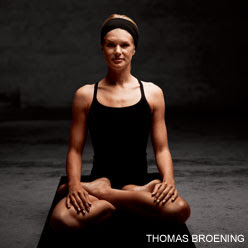Surya Bhedana Pranayama - Single Nostril Breath

(soor-yah beh-DAH-na)
surya = sun
bhedana = piercing
(chahn-drah)
chandra = moon
Step by Step
1) Our right nostril is energetically associated with our body's heating energy, symbolized by the "Sun" and the syllable HA, our left nostril with our body's cooling energy, symbolized by the "Moon" and the syllable THA.
2) In the average person these energies are typically in conflict, which leads to disquiet and disease. The goal of traditional Hatha Yoga is to integrate and harmonize HA and THA for happiness and health. The purpose of these two breaths then is to create balance by "warming" a "cool" body-mind and vice versa.
3) Sit in a comfortable asana and make Mrigi Mudra. For Surya Bhedana block your left nostril and inhale through your right. Then close the right and exhale through the left. Continue in this manner, inhale right, exhale left, for 1 to 3 minutes.
4) For Chandra Bhedana, simply reverse the instructions in (2), inhaling always through your left nostril, exhaling through your right. Again continue for 1 to 3 minutes.

(soor-yah beh-DAH-na)
surya = sun
bhedana = piercing
(chahn-drah)
chandra = moon
Step by Step
1) Our right nostril is energetically associated with our body's heating energy, symbolized by the "Sun" and the syllable HA, our left nostril with our body's cooling energy, symbolized by the "Moon" and the syllable THA.
2) In the average person these energies are typically in conflict, which leads to disquiet and disease. The goal of traditional Hatha Yoga is to integrate and harmonize HA and THA for happiness and health. The purpose of these two breaths then is to create balance by "warming" a "cool" body-mind and vice versa.
3) Sit in a comfortable asana and make Mrigi Mudra. For Surya Bhedana block your left nostril and inhale through your right. Then close the right and exhale through the left. Continue in this manner, inhale right, exhale left, for 1 to 3 minutes.
4) For Chandra Bhedana, simply reverse the instructions in (2), inhaling always through your left nostril, exhaling through your right. Again continue for 1 to 3 minutes.




